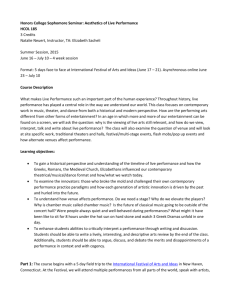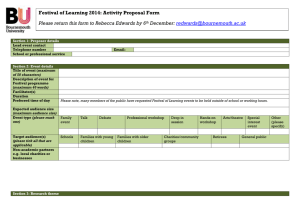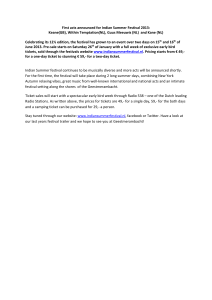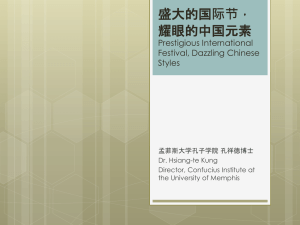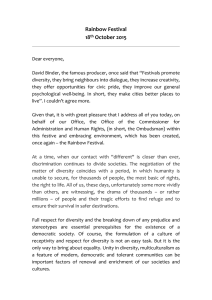Online Lecture (Video Format): In a Western context, live
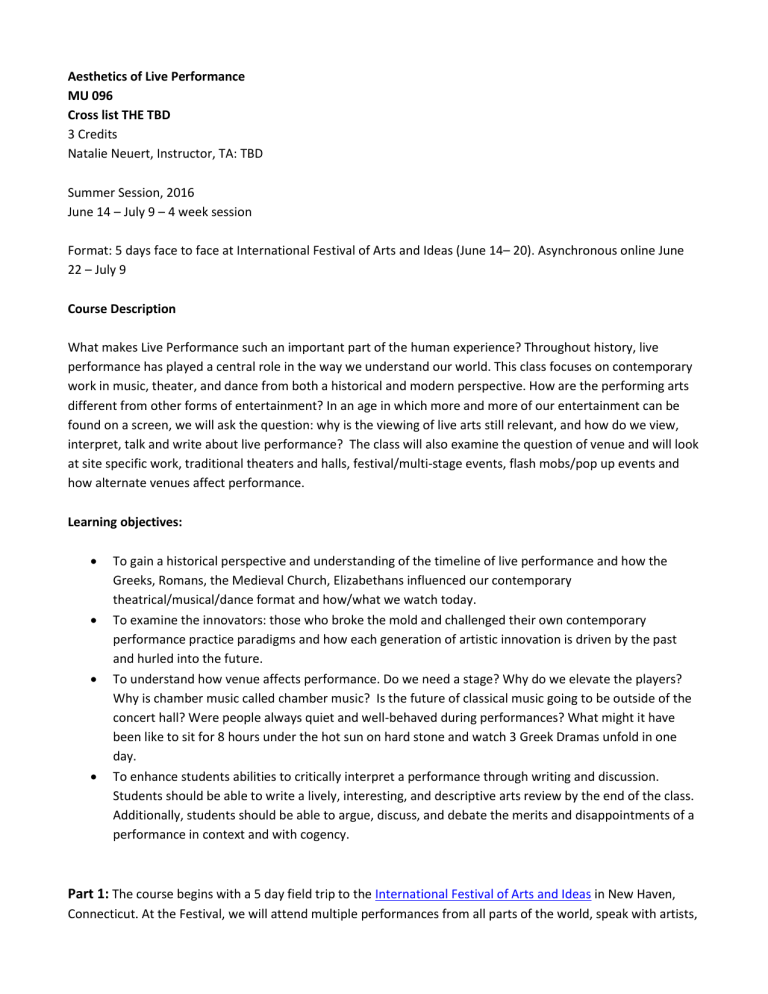
Aesthetics of Live Performance
MU 096
Cross list THE TBD
3 Credits
Natalie Neuert, Instructor, TA: TBD
Summer Session, 2016
June 14 – July 9 – 4 week session
Format: 5 days face to face at International Festival of Arts and Ideas (June 14– 20). Asynchronous online June
22 – July 9
Course Description
What makes Live Performance such an important part of the human experience? Throughout history, live performance has played a central role in the way we understand our world. This class focuses on contemporary work in music, theater, and dance from both a historical and modern perspective. How are the performing arts different from other forms of entertainment? In an age in which more and more of our entertainment can be found on a screen, we will ask the question: why is the viewing of live arts still relevant, and how do we view, interpret, talk and write about live performance? The class will also examine the question of venue and will look at site specific work, traditional theaters and halls, festival/multi-stage events, flash mobs/pop up events and how alternate venues affect performance.
Learning objectives:
To gain a historical perspective and understanding of the timeline of live performance and how the
Greeks, Romans, the Medieval Church, Elizabethans influenced our contemporary theatrical/musical/dance format and how/what we watch today.
To examine the innovators: those who broke the mold and challenged their own contemporary performance practice paradigms and how each generation of artistic innovation is driven by the past and hurled into the future.
To understand how venue affects performance. Do we need a stage? Why do we elevate the players?
Why is chamber music called chamber music? Is the future of classical music going to be outside of the concert hall? Were people always quiet and well-behaved during performances? What might it have been like to sit for 8 hours under the hot sun on hard stone and watch 3 Greek Dramas unfold in one
day.
To enhance students abilities to critically interpret a performance through writing and discussion.
Students should be able to write a lively, interesting, and descriptive arts review by the end of the class.
Additionally, students should be able to argue, discuss, and debate the merits and disappointments of a performance in context and with cogency.
Part 1:
The course begins with a 5 day field trip to the International Festival of Arts and Ideas in New Haven,
Connecticut. At the Festival, we will attend multiple performances from all parts of the world, speak with artists,
curators, and critics about their work, and immerse ourselves in global music, dance, theater and more. We will be housed in Yale Dorms and use classroom space at Yale.
Prior to the Festival students will prepare by
Pre-reading from the following required texts:
Ross, Alex: The Rest is Noise, Listening to the 20 th Century. (Specific chapters assigned.)
Byrne, David: How Music Works (Specific chapters assigned.)
MacCauley, Alistair: What Carthage Women Wanted, as Imagined (and Danced) by Men
(New York Times review of Mark Morris Dido and Aeneas)
Burke, Siobhan: Sacred Movement and Music, with an Infectious Beat
(New York Times review of Ragamala Dance & Rudresh Mahanthappa)
At least 3 of the multiple reviews and articles on Angelique Kidjo to be found at http://www.kidjo.com/in-the-press.html
Daily Schedule at the Festival will be determined once their events are released.
Total class contact hours at Festival: 11.5 hours (classroom); approx. 20 (shows/concerts/ideas sessions);
Wednesday, June 17, 2015 – Arrive and Check in to Dorms
1:00 pm to 4:00 pm: Class meeting, Yale Classroom, TBA
Review of expectations of class and what we will experience at the Festival. Discussion of history of festival, review of mission statement of festival. We will have a visit by one of the festival’s curators and a board member who will give us personal insight into the vision of this 2 week event, its scope, and what it is trying to accomplish.
Discussion of readings with specific emphasis on the three reviews of work we will see. How do we prepare to see a work of performance with unfamiliar artists? What are our expectations of the experience? What does our prior experience bring to the table? Do we view an art form differently if we are deeply involved in at as performer ourselves.
Part 2: June 22
nd
– July 10 – Online.
The online portion of the class will be organized into 3 Learning Modules. Each module will contain lectures, readings, assignments, discussions, papers, and one large-scale project which will be researched and executed in teams of 2 students.
Module 1: A Cultural History of Live Performance: Music
From June 22 nd to June 27 th
Readings during this module:
Chapters: Alex Ross The Rest is Noise, listening to the 20 th Century
Chapters: David Byrne How Music Works
Timeline Podcast from Vermont Public Radio: listening
Online Lecture (Video Format): In a Western context, live performance of music began as a way to gather people together for worship, celebration, and story-telling. How did music move into dedicated spaces and what were those spaces? When did people start paying money to listen?
Online Lecture (Video Format): We now live in an era where live music is available from big cities to small towns.
This was not always the case. This lecture explores how touring music spread across the United States in the post-war period.
Online Lecture (Video Format): Venues – where did people go to hear live music? From the big-city concert hall, to the road-house: how does venue affect the way we listen? How has the advent of recorded music and streaming affected the way we hear music?
Online Lecture (Power point format with links): Musical innovations happens for many reasons, we will look at some major innovators and discuss how they influenced subsequent performers. We will look at and listen to various pairs of cross-cultural and/or cross-historical performers. Lecture and discussion will include examples from work we heard at festival.
Discussion (Online, asynchronous – using Blackboard’s Discussion function): Following each lecture, students will respond to a discussion prompt and reply to at least 3 classmate’s postings. Discussion will also work in tandem with assigned readings to deepen student’s understanding of topics. Sample prompt: We saw work at the festival in a variety of venues: was the work performed enhanced by the venue choice? Could those events have taken place anywhere? Give concrete examples of how your response and involvement was influenced by the venue or lack of venue.
Assignment: Timeline
Moving from the Medieval Period to Contemporary Musical performance, students will create a timeline indicating major periods of genre-shift historically. Timeline should indicate both shifts in genre (from Gregorian
Chant to Renaissance Band for example) AND shifts in venue or performance viewing practice (from Church to
Village Square for example). At least 10 significant historical shifts have been noted on the time line, students will also place specific musical artists along the timeline (composers and performers can both be included).
Discussion/Peer Review: Each student will review another student’s timeline and post a discussion string around the artists they have placed along the time line.
Preparation for final Project (described below): students will be working in teams of two and will choose their team mate at this time.
Module 2: Theater as a means for social change in both an historical and modern context
Dates: June 29 – July 5
Readings
Lysistrata, by Aristophanes (available on line)
Mamet, David: Three Uses of the Knife – On the Nature and Purpose of Drama (selected readings)
Online Lecture (Video Format): Theater is one way in which humans strive to make sense their past, their lives, and to create change in social norms. Unlike music and dance, theater uses language as a primary means of communicating emotion and experience. In this lecture we will discuss the first great era of classical theater:
Ancient Greek 700 BC. The Greeks created a Festival structure as a medium for bringing drama to the public.
Though we now use this format as a medium for live music, how did the Ancient Greeks integrate the Festival into daily life, and what was its purpose? How did theater serve as a cohesive cultural event in the lives of Greek
Citizens? Is there any equivalent in our contemporary performance milieu? Would the International Festival we just attended seem familiar to citizens of ancient Greece?
Online Lecture (Video Format): When did theater move indoors and why? Why is Elizabethean theater, specifically Shakespeare, so significant in terms of how we watch theater now.
We will look at important and iconic theater structures (Theater of Dionysius, Shakespeare’s Globe, Theater am
Schiffbauerdamm – home of Brecht’s Berliner Ensemble, etc.) to understand how these structures supported and changed the drama presented within.
Online Lecture (Video Format): How and why has theater been used successfully as an agent of social change?
Assignment: Students will research a production that occurred at one of the venues mentioned above (Theater of Dionysius, Shakespeare’s Globe, Theater am Schiffbauerdamm – home of Brecht’s Berliner Ensemble). The production chosen should be one in which there was an emphasis on history, politics, social justice, or a call for change (radical or subtle). Students will write a paper in which they discuss their research.
Module 2: Dance – Movement as Narrative: Three Groundbreaking Contemporary Choreographers (Mark
Morris, Pina Bausch, Elizabeth Streb)
Dates: July 3 – July 10
Readings during this module:
Banes, Sally: Terpsichore in Sneakers, Post-Modern Dance (selected readings)
Acocella, Joan: Mark Morris (selected readings)
MacCauley, Alistair: Glimpses of India, Eruptions of Chaos, Flashes of Choreography (on Pina Bausch’s Bamboo
Blues)
Sulcas, Rosalyn: Two Immortal Lovers Have a Rematch in Paris (on Pina Bausch’s Orpheus and Eurydice)
Senior, Joan: Mark Morris
Film/Video during this module:
Pina: A Film for Pina Bausch by Wim Wenders
Born to Fly: Elizabeth Streb vs. Gravity
Online Interview: Video Format –– a timeline of contemporary dance.
In this module, discussion prompts will become a major teaching tool as we look in depth at our three choreographers (two whose work we will see captured live on film, one whose work we’ve seen live at the
Festival). Questions we will tackle with detailed writing and answers:
Joan Acocella writes how Mark Morris’s approach to his life influences his work. Yet his last two projects, including the one we have seen live, incorporate formal historic forms (such as opera and symphonic music) and classical mythology as story line. So which is it? Can work reflect the artist’s own personal experience while using historical format and construct? How does a modern audience relate to this juxtaposition?
Elizabeth Streb’s choreography defies gravity and thus takes movement to a whole new level. Can we move beyond the shock element of her work and find meaning in her search for the ultimate potential of the human body? How is her work different then extreme sports? What makes it art?
Pina Bausch’s choreography has been called both epic and intimate, but it is always on the edge of extreme human emotion. In the two written reviews of her work that we will read, and in Wim Wender’s extraordinary film, we see that it also incorporates historical and cross-cultural elements. How does the work of this distinctive artist tie together many of the themes we have discussed in our class, and work we have seen live?
Final Project: Due July 17, 2015
Topic approved by Professor: July 1, 2015
Students will research an historical period of artistic work (Baroque Music, Greek Comedy, Elizabethean Theater, etc. and find a contemporary artist whose work is influenced from this historical format/medium. Examples we have seen throughout class include Mark Morris/Ancient Greek Drama, or Pina Bausch/Classical Indian Dance.
Students will create a multi-media (music/video/textual description, etc.) presentation documenting their research and discoveries. The earlier time-line project may be a useful starting point for this project.
An assessment rubric will be supplied for this project.
Grade Assessment:
Discussion Board online and face to face discussion participation (at Festival) – 20% of grade
Timeline Project – 20% of grade
Attendance at all required Festival events – 20% of grade
Final project – 40 % of grade
